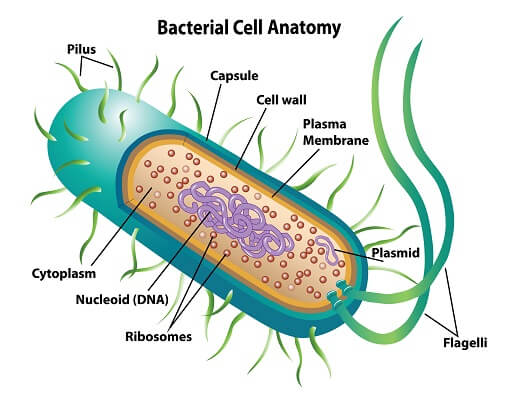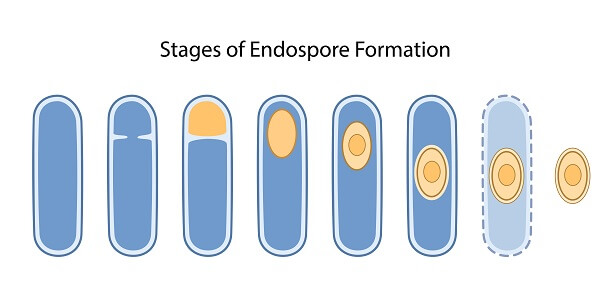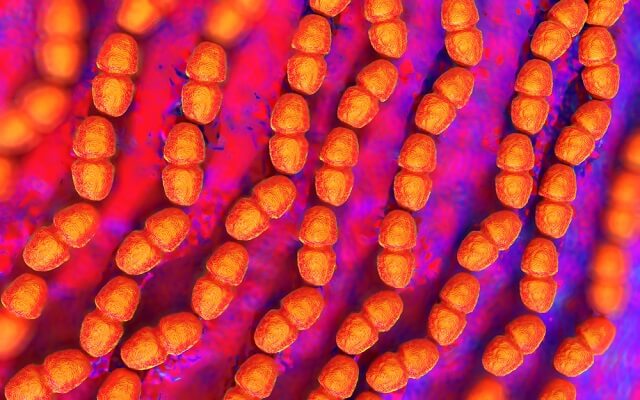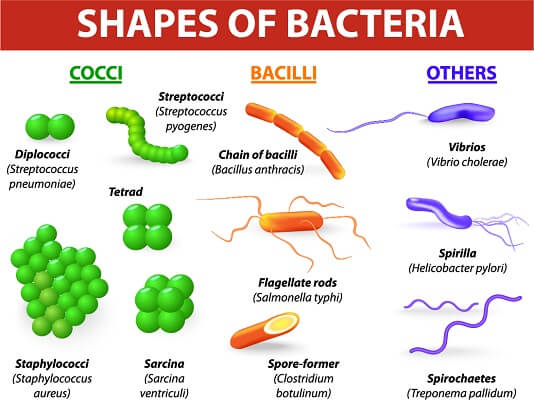Definition
Eubacteria, or “true” bacteria, are single-celled prokaryotic microorganisms that have a range of characteristics and are found in various conditions throughout all parts of the world. All types of bacteria fall under this title, except for archaebacteria. Since eubacteria are so common, this group comprises one of the three domains of life: Bacteria.
Overview
Within the prokaryotic organisms, there are two main divisions: Eubacteria and Archaebacteria. The Eubacteria are found in the domain Bacteria, while the archaebacteria are found in the domain Archaebacteria. Eubacteria have the typical characteristics of a prokaryotic organism, but they also have the ability to form spores and can be pathogenic organisms (i.e. cause disease in humans and animals). Eubacteria can reproduce through binary fission or budding, and often form large colonies that can create extracellular structures like “biofilms” that protect the colony in unique ways.
Characteristics of Eubacteria
Eubacteria, or microorganisms lacking a defined membrane nucleus, have several general characteristics. As prokaryotes, they do not have any membrane-bound organelles. Most eubacteria are enclosed by a cellular wall, which is made up of peptidoglycans in a cross-linked chain pattern. This gives the wall of the bacteria the strength needed to maintain its shape and size through changing environments. Small molecules can diffuse through the cell wall, but larger molecules and ions need carrier proteins and channel proteins to enter the cell.

Some bacteria may have a flagellum (a structure composed of protein filaments that is used for movement). Other bacteria have pili, which are small projections all over the outside of the cell that are used for sticking to surfaces and transferring DNA. When a large number of bacteria are attached to a surface and are surrounded by a polysaccharide sac, this is referred to as a biofilm. This complex has high antimicrobial resistance.
The fluid contained by the plasma membrane of the bacteria is the cytosol. It is composed of mainly water (approximately 80%), but it has a gel-like consistency because it is filled with dissolved nutrients, cytoskeletal elements, DNA, and other substances. Eubacteria do have ribosomes – organelles that are composed of RNA and protein that complete the process of protein translation.
Bacterial DNA floats freely within the cytosol, though it is concentrated in the nucleoid. Bacterial chromosomes are often circular but can also be linear in shape. This shape comes in handy when a bacterium is undergoing replication. Bacteria can asexually reproduce through binary fission or budding. Bacteria that undergo binary fission must first elongate and duplicate their DNA before separating into two new, similarly-sized cells. Budding happens when the parent cell produces a small extension of the cell membrane and fills it with duplicated DNA. Binary fission produces two equal daughter cells, while budding produces a small, new cell while the parent cell remains quite large.

During times of extreme conditions not conducive to replication, such as starvation, eubacteria have the ability to become endospores. In this state, the bacteria can tolerate exceedingly high and low temperatures, acidic and basic conditions, and large amounts of radiation. Endospores are extremely hard to kill. Surprisingly, they can be boiled for hours and still survive. Endospores can only be made by Gram-positive bacteria. Within the endospore remains the bacterial DNA, but the cytosol loses water and becomes extremely concentrated. This is thought to help in protecting against high heat. The bacteria will take on a tough coating composed of calcium and dipicolinic acid, creating a dense and impregnable barrier to stabilize the DNA within the cell. DNA repair enzymes are also still active, aiding in the resistance of the endospore.
Plasmids are also found within bacteria separate from the bacteria’s circular DNA. Also referred to as “replicons”, plasmids are autonomous replicating DNA molecules. Essentially, these small rings of DNA allow bacteria to transfer genes between organisms. These elements allow for horizontal gene transfer, which is a way for a bacterium to gain new genes and traits – such as antibiotic resistance. They primarily aid in the rapid mutation in bacteria to changing environmental conditions. Similar to the other genetic material, the plasmids can be passed onto daughter cells during replication.

Archaebacteria vs Eubacteria
Archaebacteria and Eubacteria are both prokaryotic, though these organisms exist in different biological domains because they are so genetically different. It is thought that archaebacteria are some of the oldest forms of life on Earth, while eubacteria arose later in evolutionary history. Eubacteria are now found in almost all environments, whereas archaebacteria have been pushed to only the most extreme environments – such as high salinity lakes, thermal hot springs, and deep within the Earth’s crust.
There are a few other differences between these groups. For instance, archaebacteria are not susceptible to antibiotics, while most eubacteria are (unless they have developed resistance.) Archaebacteria typically do not infect humans (or aid in digestion), so this is generally not a problem for human health. Further, eubacteria have the ability to form spores to survive adverse conditions, while archaebacteria do not have this ability.
Types of Eubacteria
Bacteria commonly take on one of three shapes: bacilli, cocci, and spirilla. Bacilli have a rod shape, cocci have a spherical shape, and spirilla have a spiral or wave shape. Their shape was often used as a classification system until recent DNA studies cast doubt on these classifications. Bacteria may stay linked after division, forming other shapes such as clusters, filaments, and tight coils.

Eubacteria are typically classified into Gram-positive, Gram-negative, and Miscellaneous. While there are many phyla of eubacteria under the Domain Bacteria, these relationships are often changing and are still being defined based on new DNA experiments.
Some bacteria have an additional layer enclosing the cell wall referred to as the bacterial outer membrane. This extra layer cannot be dyed with a Gram stain that is often used to classify bacteria by researchers. Thus, they are referred to as “Gram-negative” bacteria or Bacteria that can be seen with a Gram stain are referred to as Gram-positive. Typically, Gram-negative bacteria contain more species that are pathogenic to humans, whereas Gram-positive bacteria are either beneficial or not harmful to human health.
Examples of Eubacteria
Escherichia coli, abbreviated to E. coli, belongs to the Eubacteria domain. It is classified into the Proteobacteria phylum. It is rod-shaped and Gram-negative, so it has an additional membrane surrounding its cell wall. E. coli is commonly found in the gut of many different types of warm-blooded hosts, including humans – though it can become pathogenic under the right conditions. Most strains are harmless (and possibly beneficial), but some can cause food poisoning and other illnesses. The bacteria can only survive outside of a host for a limited time.
Streptococcus pneumoniae, abbreviated to S. pneumoniae is another common eubacteria. It belongs to the Firmicutes phylum. It has a spherical shape and is Gram-positive. S. pneumoniae can be found on healthy hosts in the respiratory tract, nasal cavity, and sinuses. However, the bacteria can become pathogenic and spread to other parts of the body, often causing pneumonia and meningitis in immunocompromised hosts. The bacteria in high amounts can cause other illnesses as well, including, but not limited to, bronchitis, acute sinusitis, and sepsis.
These examples both show how the Gram-positive vs Gram-negative classification of pathogenic bacteria can be misleading. Many species of bacteria can be helpful or harmful under different conditions.
Quiz
1. Which phylum is not included in Eubacteria?
A. Chlamydias
B. Blue-green algae
C. Proteobacteria
D. Archaebacteria
2. What is NOT a common shapes bacteria take?
A. Spirilli
B. Cocci
C. Bacilli
D. Squamous
3. How do eubacteria proliferate?
A. Binary Fission
B. Budding
C. All the above
D. None of the above
